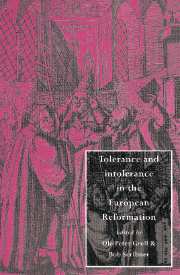Book contents
- Frontmatter
- Contents
- List of contributors
- Preface
- Dedication
- 1 Introduction
- 2 The travail of tolerance: containing chaos in early modern Europe
- 3 Preconditions of tolerance and intolerance in sixteenth-century Germany
- 4 Heresy executions in Reformation Europe, 1520–1565
- 5 Un roi, une loi, deux fois: parameters for the history of Catholic-Reformed co-existence in France, 1555–1685
- 6 Confession, conscience and honour: the limits of magisterial tolerance in sixteenth-century Strassburg
- 7 One Reformation or many? Protestant identities in the later Reformation in Germany
- 8 Toleration in the early Swiss Reformation: the art and politics of Niklaus Manuel of Berne
- 9 Tolerance and intolerance in sixteenth-century Basle
- 10 Exile and tolerance
- 11 The politics of toleration in the Free Netherlands, 1572–1620
- 12 Archbishop Cranmer: concord and tolerance in a changing Church
- 13 Toleration for Catholics in the Puritan revolution
- 14 The question of tolerance in Bohemia and Moravia in the age of the Reformation
- 15 Tolerance and intolerance in sixteenth-century Hungary
- 16 Protestant confessionalisation in the towns of Royal Prussia and the practice of religious toleration in Poland-Lithuania
- Index
9 - Tolerance and intolerance in sixteenth-century Basle
Published online by Cambridge University Press: 07 December 2009
- Frontmatter
- Contents
- List of contributors
- Preface
- Dedication
- 1 Introduction
- 2 The travail of tolerance: containing chaos in early modern Europe
- 3 Preconditions of tolerance and intolerance in sixteenth-century Germany
- 4 Heresy executions in Reformation Europe, 1520–1565
- 5 Un roi, une loi, deux fois: parameters for the history of Catholic-Reformed co-existence in France, 1555–1685
- 6 Confession, conscience and honour: the limits of magisterial tolerance in sixteenth-century Strassburg
- 7 One Reformation or many? Protestant identities in the later Reformation in Germany
- 8 Toleration in the early Swiss Reformation: the art and politics of Niklaus Manuel of Berne
- 9 Tolerance and intolerance in sixteenth-century Basle
- 10 Exile and tolerance
- 11 The politics of toleration in the Free Netherlands, 1572–1620
- 12 Archbishop Cranmer: concord and tolerance in a changing Church
- 13 Toleration for Catholics in the Puritan revolution
- 14 The question of tolerance in Bohemia and Moravia in the age of the Reformation
- 15 Tolerance and intolerance in sixteenth-century Hungary
- 16 Protestant confessionalisation in the towns of Royal Prussia and the practice of religious toleration in Poland-Lithuania
- Index
Summary
The topic of this chapter has been widely discussed in recent historical literature. I may not have much to add, but I do not intend to offer just a summary of already published results. Instead I should like to focus on a few specific manifestations of tolerance and intolerance in sixteenth-century Basle which I have studied with particular interest and insistence for a number of years.
In the first part of this chapter I should like to say something about how the behavioral attitudes which we define as tolerance or intolerance appeared during the Reformation period. The second part shall be devoted to the history of Basle from around 1540 to the end of the sixteenth century. There I shall draw from my research on Sebastian Castellio.
In Basle like everywhere else the Reformation was a fundamentally intolerant movement of religious renewal which struggled against an equally intolerant establishment of ecclesiastical tradition. This establishment was particularly strong here because Basle was an episcopal seat with a bishop, a chapter, and a complete administrative and spiritual infrastructure. That the last bishop residing in Basle was an admirer of humanism and a man of conciliatory inclinations did not change the situation fundamentally. The Reformation was carried through by a group of reform-minded parish priests and monks who were actively supported mainly by members of the craft guilds. Victory was reached in early February 1529, after an outburst of iconoclasm and a short-lived political rebellion.
- Type
- Chapter
- Information
- Tolerance and Intolerance in the European Reformation , pp. 145 - 163Publisher: Cambridge University PressPrint publication year: 1996
- 4
- Cited by



